Linda Maye Adams's Blog, page 14
May 8, 2022
New Pantser Rebellion Book for May
I’ll be releasing a new Pantser Rebellion book later this month. I did this book because I was frustrated with resources that treated what we do as fiction writers (and pantsers) as if we were still in school. I don’t know about you, but I don’t want to take notes like I’m being tested on them. I want them to benefit my creativity. Look for this on May 24.
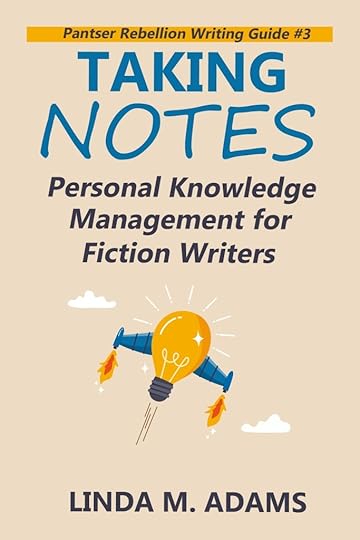
Do you have trouble figuring out how to take research notes for writing fiction?
In this writer’s guide, Linda M. Adams reveals how she takes notes for her stories, using pantser writing techniques
The secrets of how are easier to learn than you think.
• The difference between what we learned about note taking in school and what we need to write fiction
• Traps to avoid when note-taking
• How to take notes for book research and writing workshops!
This book shows you how to write smarter and be the writer you’ve always wanted to be. Join the Pantser Rebellion!
May 1, 2022
May Check-in
May is Creative Beginnings month. It’s a great time to start a new story! I’m just finishing up Dice Ford 2: Weekend With Superheroes. I’ll be starting on my fifth GALCOM Universe book, as yet untitled. I might have some fun roaming over to the Pulp Fiction index and mash up some titles.
I’m also working through publishing all of my stories from the Great Challenge, plus a review of my entire inventory. While I was at Superstars in February, I received self-publishing templates that cut my time creating an ebook drastically.








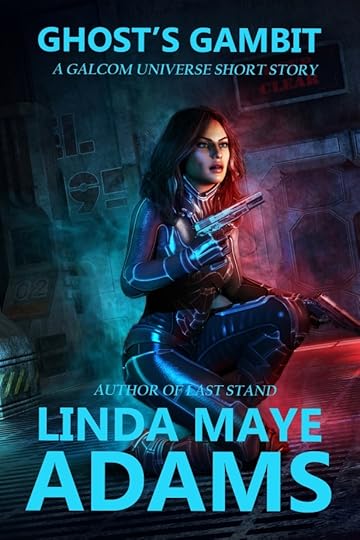
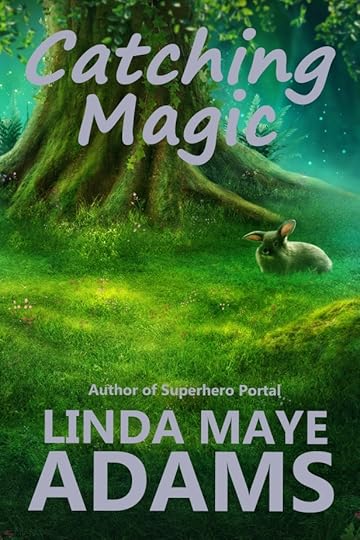

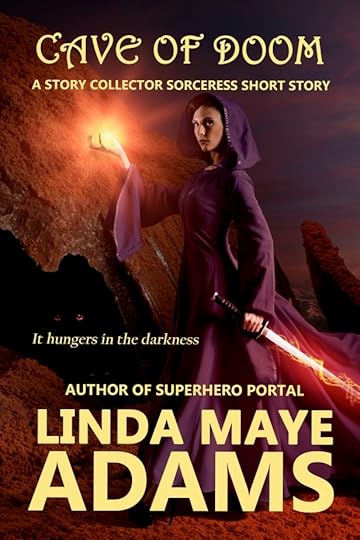
Also on tap for May is the Fantasy & Science Fiction giveaway. There are some amazing books on the list, so have a look for anything you want. I don’t know what it’s like where you’re at, but Virginia’s been cold! All I want to do is hibernate with books. This giveaway includes two bundles, so more books, all in one tidy package!

April 7, 2022
Submitting to Magazines
Sometimes I follow a random path into writing courses. This week, that path took into one called Reaching Pulp Speed (Pulp One is 1 million words, like Star Trek’s Warp One. Engage!).
First lesson and bang! First lesson, if you can’t do the business side, like publishing or submitting the stories to get them out there, you’re not ready to look at pulp speed.
And when I answered the question of why, I really couldn’t come up with a good reason. Sometimes the Critical Voice gets involved there, like when I get a rejection, it says, “The story isn’t any good” or “No one
wants that story.” And time isn’t really a good reason either.
So I’m working through getting every short story not indie-published out the door (11 so far).
Since someone asked about picking the magazines previously, this is how I’m picking where to send the stories:
1. Word count and genre in hand, I search The Submission Grinder. My search criteria includes those two, plus a 5 cents per word payment.
I remember a writer said to start with the top paying, then work your way down until it gets published. Unfortunately, it encourages writers to settle for less, just to get published. Start at the top, stay at the top.
2. This step is the conveyer belt part of the process. I start at the top of the list and open each magazine. I scan the Grinder page and eliminate any that are obviously not a good fit. Some say they are fantasy and they’re dark fantasy. Or they only accept submissions from Canadians. Sometimes the 5 cents a word is for flash fiction and short stories pay 3 cents.
3. Once I find a likely magazine, I make sure I’m checking off the box on all their requirements. If they want something different from Shunn, I re-save as TitleOfStory-Magazine and make all the changes to the format.
4. Then it’s time to draft the cover letter. That also comes from the guidelines. Most of this is a lot of cut and paste, though. I save it as Cover Letter Magazine.
5. Send it to them in whatever way the magazine wants.
6. Record the submission on my submissions tracker
spreadsheet. If they give me a reference number, I include that. Right before COVID hit, I had a story on submission. I think the magazine lost it in all the chaos that followed. I was able to determine the story had disappeared from their submission tracker entirely, but I think it would have helped to have the reference number.
7. When they respond, I PDF Print the email and shift the submission entry to the story’s worksheet tab.
8. Then I restart the process over again.
April 2, 2022
April Writing Tips: Personal Knowledge Management

March in Washington, DC always bounces around with the weather while spring makes up its mind to decide to stay. It’s like the arrival of the cherry blossoms triggers winter to hang on a little longer. We were in the 60s and 70s the week before. This week? Teens with wind chill. I walked by a fountain and there were icicles hanging off the shrubs blooming around it!
But I spotted this deer while I was out for a walk, nibbling on the few green leaves that had already sprouted.
Soon…
Earlier this month, my county offered a writing course that got enough of my attention to investigate further. These days, I always view writing courses with partial suspicion. Nearly everything markets to newbies–writers who are starting their very first novel and may never finish.
This course was on how to research the Washington, DC area for a historical novel, along with tips on how to put it into the story.
Cool. I figured the instructor was a historian, thought I might get some new insights.
So I researched the course first before I parted with money or time. The course was $99, and three sessions of 2 hours each, plus driving time.
According to the adult education site, the instructor was a lawyer who’d written historical novels. Hmm. I found that odd. Maybe he’d researched the area as part of studying for the bar? I know someone who did that.
Off to his site. He’d published three novels with a small press publisher. Sample chapters were provided, so I picked the first one. Read the first page. Went to the third book. Read the first page.
Passed on the course.
No setting on the first page to tell me the book was set in Washington, DC. Nothing suggested a historical novel. Only dialogue. I instantly felt myself tuning it out. How do you get to know a character with untethered dialogue?
I think about this a lot. I’m working on a book called Taking Notes: A Guide for Fiction Writers. There’s a lot of discussion on personal acknowledgment management systems (PKMs)–a fancy name for a place to store your notes. Tiago Forte has a book coming out on the topic in a few months (which I’m going to read).
Everyone is racing to scoop up all the information bombarding us on a daily basis into a PKM. Some of it seems to stem from the fear that if you don’t record every single thing down you’ll miss out on the connection that leads to that Big Idea, that Big Innovation, that Big Widget.
One blogger stated that he knew his PKM system was breaking down when he didn’t record notes on every single book he read.
First thing I thought was, “Dude, that’s a sign your Creative Voice is telling your Critical Voice to shut the **** up!”
Because this collecting of information is pure Critical Voice.
But it looks like you’re feeding your Creative Voice.
Until suddenly you realize you’ve done a lot of X–whether it’s taking notes, doing world-building or marketing, or attending a class that doesn’t have much value–and you haven’t done the writing.
The worst part is that this piece of Critical Voice absolutely looks like it’s being productive.
Worse, it’s common writing advice for research!
Just about every site that gives research tips for fiction writers uses what I call the School Standard: research everything, even if you don’t need it.
This is a vestige of the days of taking tests. Where you feared missing something that would be on the test, so you recorded everything.
Screen your resources carefully, like what I did with the historical research class. Ask what immediate value and future you’re going to get from taking the notes.
If you hear, “I might need this,” that’ll be your Critical Voice. Give it a Gibbs head smack.
March 5, 2022
March 2022 Planning Tips
I’m using this idea of the Productive Flourishing site. I always feel like anyone talking about time management or planning is talking to someone else, instead of to people like me.
This one started out as coming from Superstars, and Adriel Wiggins‘ workshop on continuity editing. She talked about using a white board to create a layout for your setting.
I thought it was a pretty good idea, so I bought two 11X17 white boards (Target’s got them. They’re under $10). Tried a setting for Dice Ford 2.
Then I thought about writing a witch cozy short story (it turned into a novella project because the anthology requirements were contemporary. My story was set in the 1940s). So I grabbed the white board and I hit some genealogy sites to look up last names. Just made a list. Hit the social security site for popular names in the 1900s.
After that, I hit vintage clothing sites and did research on styles and colors of the clothing the characters would wear.
As I started writing the first few chapters, I added in the description of the characters, what they were specifically wearing in the scenes I was working on., grabbed one of the last names off the ones I’d come up with.
It saved a lot of time. I now have five boards (because, as Productive Flourishing notes), you can’t do more than five projects at time. One was for the actual short story for the call, which included the basics I needed to hit from the guidelines (you know, word count, elements I have to make sure are in the story). I also did some quick research on the first scene’s setting.
In doing one for Dice 2, I realized an item of clothing she was wearing dropped off my radar and it would have become a problem in the later scenes. So I made it a problem.
Better still, I did the detail research I needed before I started, so I wouldn’t have to stop to do it while I was writing. Huge time saver!
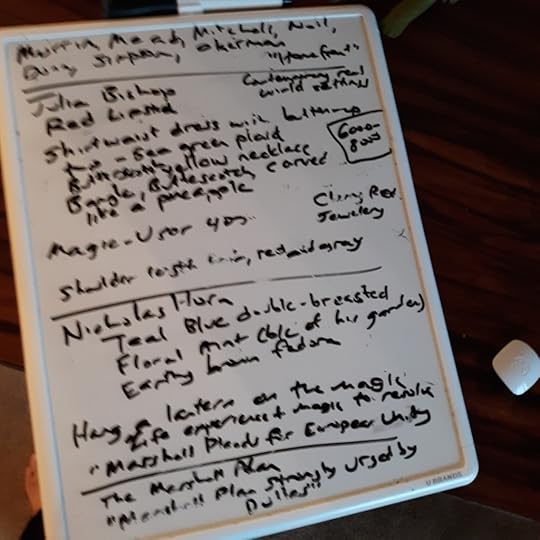
February 27, 2022
Wisdom in Words
Sheila Chandra says in Organizing Your Creative Career to always return to the guidelines before you start your project to do a quick review. Basically, make sure that you don’t start the project before you recheck what it requires.
Because it’s sometimes easy to miss a detail, especially with us creative types. I was planning on starting a story for an anthology call. I had the perfect story that would fit. I was going to set in 1940s because I doubted anyone else would do that. It would also have a dog in it.
Spent time yesterday morning coming up with potential names for the characters. With the setting, I had to be careful to get names that:
Weren’t too old-fashionedFelt like they could be used today.Didn’t feel like an anachronism (Katie was a name used then and my first reaction was that people would think it was too modern).So I searched for 1900s last names and pinged on a university site that had posted a list of the names in the local census. I started listing all kinds of names because I knew I was going to need some not only for my main character but other characters.
Then I did some quick research for the story. Since it’s the 1940s, clothes are an easy way to establish the era. They were very distinctive and also shows the character. One of the sites had a timeline of the fashion changes and historical events, and I pinged on one event. Searched on images for the historical event and landed a headline I can use in the story (that’s from Kris Rusch).
Then I zoomed back to reread the guidelines to make sure I covered everything they wanted.
And discovered they only wanted contemporary stories. Whoops!
So that story will become a novella and I’ll have to come up with another one for the anthology call. But I’m glad I reviewed the guidelines carefully first so I didn’t send them a story they were going to reject out of hand!
February 22, 2022
Superstars and new cover
I came back from the Superstars Writing Conference last week. Am still recovering.  It’s a lot of information. One of the great things about the conference is that it treats you like a professional writer and respects you by giving you differing opinions.
It’s a lot of information. One of the great things about the conference is that it treats you like a professional writer and respects you by giving you differing opinions.
I’ve been to other writing conferences where everyone is treated as a newbie and clueless, and they don’t expect you to actually get published.
One of the sessions was a two-parter that wasn’t enough time for what it was–on building a book using Microsoft Word. I almost didn’t attend because I know how to do that. Well, the instructor showed me some things I didn’t know, and I picked up on two programs I didn’t know about either. One was Jutoh, for building the book (everything’s been on Mac only, so I ignored this previously. Now there’s a Windows version). Another was Affinity, a new image program that rivals Photoshop. I even got some templates!
So I spent the last few days trying out the new process and built a collection of my Al Travers mysteries called Stain of Secrets.
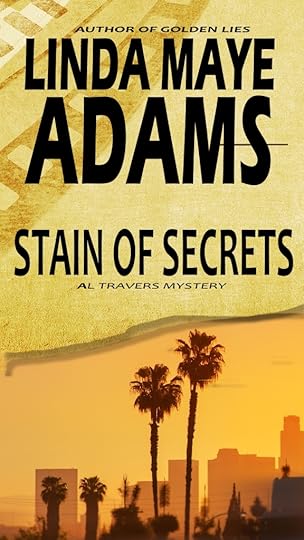
Stain of Secrets
When Hollywood stars play on the edge, secrets become dangerous for private investigator Al Travers in these five mystery tales.
An actress…frightened, desperate. Her producer husband missing. Al searches for the truth in “The Last Gamble.” But in Hollywood, truth and lies mix. He must decipher the baffling clues. But he fears he may be too late to save the husband.
Al wakes up in an alley—next to a dead woman. Framed for a brutal murder, he flees from the police. He must unravel shocking clues from his “Lost Night” to the real killer before his fate turns for the worse.
A movie executive summons Al to investigate the death of a star on the set in “Backlot Deception.” The suspect? A movie director Al idolizes. As he searches for the truth, the answers to what happened may take a heart-breaking turn.
Jean Hartman, an upcoming star…kidnapped, held for “Ransom.” The studio refuses to call the police. Al must find her before time runs out.
Actress Lily Boone misses her shooting calls for the last two days. Seems a routine check for Al Travers. But he’s about to find out how twisted anything routine in Hollywood can get in “Lone Red Shoe.”
A page-turning historical mystery collection of 1940s Hollywood!
I’m still working on the build. Since it’s a new process, it’s taking some time. But the process forced me to do the blurb first so I could put it in the book (there’s a spot in the template), and then it would also get picked up by the spell checks.
Stories 1, 2, and 4 are out of the Great Challenge. Story 3 I did right as COVID-19 kicked off, so it was a major accomplishment in trying circumstances.
January 30, 2022
Critical Voice and Word Count
We’ve been unbelievably cold in Northern Virginia. The kind of cold where it gets in through the windows and sucks the heat right out. We haven’t hit much higher than a wind chill of 12, and it’s been a wind chill of five right at dawn.
My writing woes are critical voice. I decided to take “Killing Critical Voice” and confirmed that was my problem pretty fast. Right now I’m rooting out all the areas where critical voice takes control.
The first one? Word count.
It’s insidious. If you deal with writers online at all, they all talk about having word count goals, writing a certain number of words a day. They have elaborate spreadsheets to track word count.
Me? I set a word count goal, critical voice takes charge. If I track word count, critical voice tut-tuts at every entry, saying, “I have to monitor the word counts, how many pages the chapter is, and inform her when she’s not making that goal.”
It started with the first novel. I’d never tried anything that big before, and I didn’t know what I was doing. At the time, traditional publishing was the only game available. I thought a novel was 50K, which was freaking huge as it was. Then someone told me the bottom number was 90K.
So I fixated on word count. It became the goal of the novel, not enjoying writing it. Every bump up was a cheer. Every bump down was horrifying.
Cycling added to the problem and I stopped doing it for a while. My creative voice took out the garbage critical voice shoved into the story to make word count. Then critical voice wrestled control back because the word count dropped.
Even though a book can be shorter under indie, everyone still focuses on the metrics. Setting a daily word count goal and checking the box on hitting your numbers. Last week I looked at a book called The 12 Week Year for Writers: A Comprehensive Guide to Getting Your Writing Done. A lot of it is about charting out your progress in 12 weeks and grading yourself on it (I think it’s the reason I decided to take Killing Critical Voice).
It’s everywhere!
So I shall be working on figuring out how to give the critical voice a Gibbs head slap. I also have to identify four more areas critical voice has been romping around in.
Meanwhile, I put another collection up for preorder with a February 22 release. It’s called Ring Twice for Ghosts. The first two stories are from The Great Challenge.
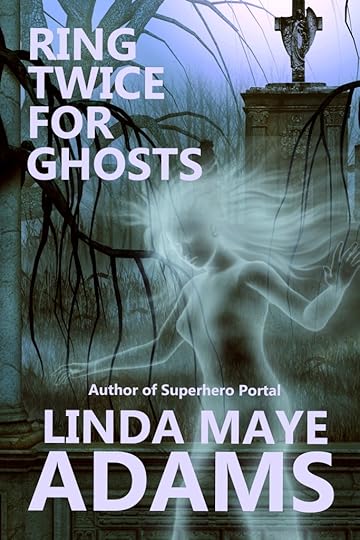
Five twisted tales of ghosts from the beyond…
In Teddy Bear Man, Nanette Perry fears placating a haunted house as her marriage crumbles. Can she solve the puzzle in time?
A Silver Honorable Mention from Writers of the Future.
Abby Gregg inherits a ship graveyard. Facing family pressure, she must make a decision that will change her life forever in Gregg Bay.
The house with the strange stones in the yard frightens Maricruz. Dark secrets hide in those stones, chilling secrets in The Stones Next Door.
In Map-Mage, Pap and his mage partner Ariana investigate the mysterious death of a mapping team. But when a pirate ghost threatens them, they must risk it all to uncover the truth.
Much to his family’s embarrassment, Marc never had showy magic like fire, levitation. Instead, he cleans magic residue. Now he faces his greatest cleaning challenge—a ghost! Find out how he tidies a ghost in Magic Tidying.
If you like ghosts, read these exciting stories for paranormal thrills and chills!
January 23, 2022
Default Words and a New Book
I’m slowly working my way through the first chapters of Dice Ford 2. It’s been a bit of a struggle. I’m not sure if it’s the inner critic—I may take the workshop on Critical Voice to assess. But it could also be just that it’s the beginning, which I found from writing the short stories had to be solid for me to write the rest of the story.
One of the things I’ve discovered is about default words.
There’s a lot of writing advice out there that says not to use the thesaurus, that whatever your creative side puts in is fine.
That’s not always true though. So much of writing advice teaches us to fear doing anything!
I’m finding that I have default words. They’re the first thing that I come up with and sometimes they’re not the right word for the situation.
For example, I was describing a city street packed with tourists. My default word was crowds. Make sense right? Well, I looked it up in the thesaurus, mostly to see if I could vary the word since I used it three times.
And I found out that there was a better word to describe the street: Throng. The two words weren’t interchangeable. So some of my writing has been to stop and look words up.
Word pet peeves: Bemused and amused are not the same thing. Neither is smirk and smile. I read one book where every single character smirked.
Also, I got a new release out. It’s a different kind of book for me called Grocery For One: Budget Saving Strategies for the Solo Cook.
I finished the first draft at the end of December. Then I watched Out of Stock on Discovery Channel. If you haven’t seen it, it’s well worth watching to understand why we have supply chain shortages. The shortages would have happened eventually, but COVID-18 sped them up.
After watching the show, it became apparent that the section on sales I’d included was out of date with the current situation. So a cycling pass to reshape the book. I wrote it because I got tired of seeing hand-wavy tips that said, “Just meal plan! That’ll save you tons of money.” (nope) or “Clip coupons” (doesn’t work if you don’t buy processed ingredients).
It’s up for preorder with a release of February 22.

Grocery for One
If you’re a solo cook, you know how challenging it is to shop for food each week. Grocery stores cater to families, solo cooks an afterthought. Websites recommend tips that aren’t always realistic when you’re the only one cooking, like meal planning or batch cooking every meal.
Add inflation and supply shortages…what’s a solo cook got to do?
Grocery For One: Budget Saving Strategies for the Solo Cook provides strategies for saving money when you shop, including:
How inflation may affect what you buyDemystify the grocery listProducts to stop buying nowNo gimmicks! No tricks! Just commonsense methods that work.
I also did the copy edits for another collection, called Ring Twice for Ghosts. Cover:
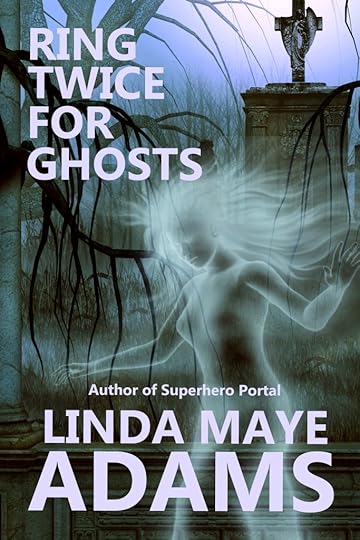
January 18, 2022
Write One Draft: How to Cycle in Your Story
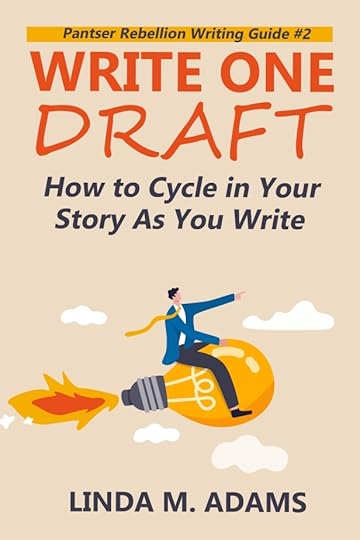
This book is now available for preorder! It will be available on January 25, along with Superhero Portal!



